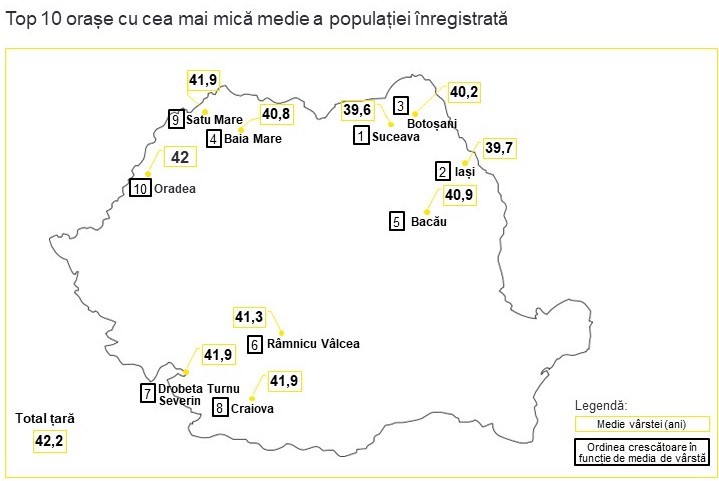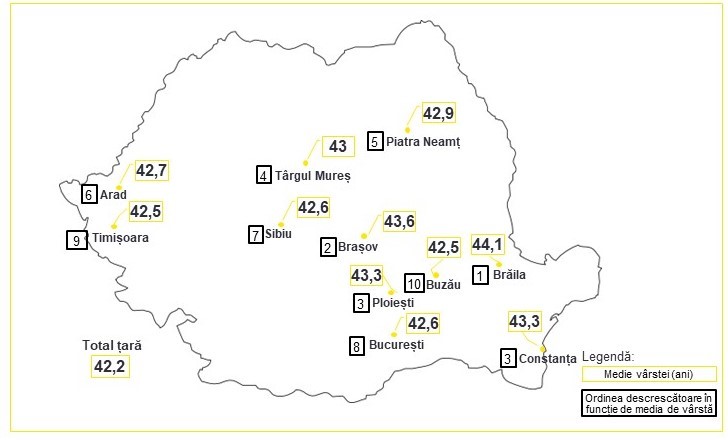Over the last five years, the share of the young (under 15) segment in the total population has declined progressively, reaching 14.8% in 2018. On the other hand, the number of Romanians aged over 65 exceeded the number of those under the age of 15 starting with 2014.
The average age in Romania has increased by about 4 years over the past two decades, reaching 41 years in 2018.
In the same period, the highest percentage of elderly among the Romanian urban population was registered, one in six persons over 65 in 2018. Cities are often perceived as the place of young people, but the reality is that many Romanian cities now have an aging population. How does the age of the inhabitants influence the evolution of a city?
Is it confirmed the perception that we encounter more young people in urban areas?
Compared to the national average, the average age of the inhabitants of the Romanian cities with more than 100,000 inhabitants is higher, 42,3 versus 41,2 in Romania.
And the average age is even higher for larger cities, although they usually benefit from the existence of anchors, such as various institutions and universities, hospitals, or cultural objectives that all represent an attraction for young people.
On the other hand, secondary cities offer some of the dynamism of their larger counterparts, but at a lower cost. This situation has created an exit mainly for young people in large metropolitan areas looking for lower life costs, avoiding crowding, and cheaper access to entrepreneurial resources. In this context it is important to mention that the average age of the rural population is lower than that recorded in urban areas (40.7 rural vs. 41.6 urban) in 2018.
Young cities in Romania
The city with the youngest population in Romania is Suceava, with an average age of 39.5 years and only one out of eight people over the age of 65. It is also followed by two cities in Moldova: Iasi (39.7) and Botosani (40.2).
Iasi and Botosani have the highest percentage of inhabitants under the age of 18 - 19.1% in 2018. This is explained, in the case of Iasi, by the birth rate, which shows the highest value compared to the other cities - 11.3 births per thousand inhabitants, but also with the national average, of 9.3 births per thousand inhabitants in 2017.

Cities in Romania with a high average age
At the opposite end, the city of Braila has the most aged population, with an average age of 44.1 years.
At a very large difference, it ranked second in the top of the aging cities in Brasov (43.6 years), followed closely by Ploiesti and Constanta (43.3 years).
These cities record the highest values in terms of the number of people over 65 (Braila, Constanta, Ploiesti - 18%, Brasov - 17% of the total population). We observe that cities with a large number of people who meet the retirement age are in tourist cities, whether we are talking about the mountain area - Brasov or the sea - Constanta.
The values recorded by the population aging index support the conclusions above, the Constanta and Brasov municipalities rank first in terms of the number of elderly persons registered per 100 young persons - 137 persons, compared to the national average of 110 persons. The capital is in the top 10 cities with the highest age in Romania, ranked 9th with 42.6 years, at a very small difference from the national average (42.2).
Although with a fairly high birth rate - 9.7 births per 1,000 inhabitants, the capital is still losing human capital due to emigration, but to the greatest extent of negative natural growth.
Evolution over time
92% of the large cities (of those analyzed) recorded population decreases in the last 18 years. The largest recorded decrease is in Braila municipality with a loss of 13% of the population in the analyzed period. On the opposite side we have three cities - Iasi with a population growth of 13%, Suceava 3% and Cluj-Napoca 1%.
It is worrying that the number of people aged 65 and over in cities has increased by 51% in the last 20 years, exceeding 1 million in 2018. If we relate to the total population of Romania, 29% of young people are in big cities, 4% less compared to 2000. On the other hand, the number of older people (over 65) increased during the same period, reaching an average of 6% (24% in 2000 vs. 30% in 2018).
Conclusions
A younger population can bring benefits such as attracting investments, so companies can find the right employees easier. However, cities also have to offer other opportunities for young people, such as cultural facilities, schools and affordable housing. Cities with older populations have different benefits and challenges
Older people, but still active, tend to be more productive and can have higher wages because of their experience and abilities.
This leads to an increase in disposable income that can be used in shops, bars and restaurants. But it is also true that cities with older people face greater demands in terms of health and social care.
Thus, as their populations continue to differentiate, cities will become more and more concentrated on the needs of their own inhabitants.
Adriana Tabac, Marketing and Communication Director, EY Romania: "As in other countries, cities in Romania face, besides demographic problems, challenges related to the development and sustainability of infrastructure, population health, well-being and housing facilities. High costs, pollution, climate change and increased traffic have already had real effects on the urban population, continuing to increasingly constrain the attractiveness of large cities and their ability to grow, as is the case in the world. "































